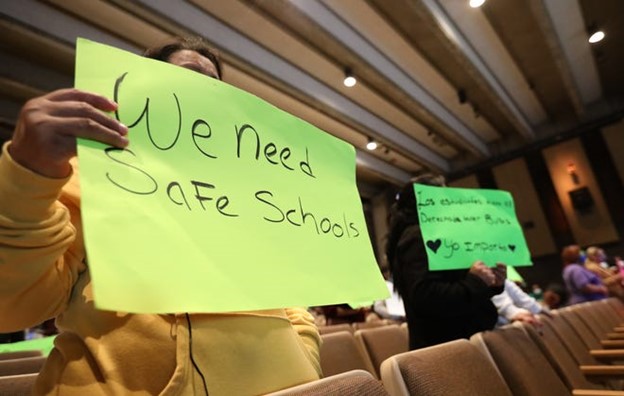Foil: Your right to Know.
- A recent building survey failed every school because the water issue, detected 7 years ago, had not been fixed.
- Students have been provided bottled water since the health issue was first revealed in 2016.
- Moody’s changed East Ramapo’s outlook to ‘negative’ for certain lending, citing the building issues and lack of fiscal stability. The district’s bond rating remained one step above ‘junk.’
“Lead-laden sink fixtures, shut for seven years, are slated to be replaced throughout East Ramapo schools within a year, according to East Ramapo and state Department of Education officials.
The state confirmed the planned work in communications with The Journal News/lohud and with the New York Civil Liberties Union. East Ramapo Superintendent Clarence Ellis also referenced the lead fixture replacement during an Aug. 15 school board meeting.
Also this month, the district saw one ratings agency change its outlook on certain bonds to “negative,” citing, in part, the condition of East Ramapo school buildings and a continued lack of local investment by taxpayers.
Both the district and SED have said the planned work on sink fixtures is part of the district’s massive building repair project funded by $90 million in federal COVID relief aid.
Documents supplied by the state and district do not provide the specific costs for the fixture replacement. A state Department of Education spokesperson said water fountains and sink fixtures would be replaced during an upcoming phase of repairs that focuses on Americans with Disabilities Act adjustments, when bathrooms are being renovated.

Parents hold up signs in protest during the East Ramapo School Board meeting at Pomona Middle School in Pomona on Tuesday, October 19, 2021. John Meore/The Journal News
How we got here
The water situation gained renewed attention this summer after a state-mandated building conditions survey failed every school building because of the lack of water supply. The building survey also rated other conditions “unsatisfactory” for most district-owned buildings.
The New York Civil Liberties Union called the situation “environmental racism” and local elected officials blasted the delays in fixing the issue that impacts certain drinking fountains and bathroom sinks.
The water contamination was detected in 2016, in the wake of Flint, Michigan’s water issues. At that time, all New York schools underwent lead testing; many schools found problems and most remedied the issue within weeks or months. Repairs in East Ramapo lagged amid fiscal troubles that continue to burden the district.
A child’s developing brain and nervous system are more susceptible to the toxic effects of lead. District children have had access to bottled water for drinking. Water for handwashing is considered safe, according to the U.S. Centers for Disease Control and Prevention.
East Ramapo:All schools fail state-mandated building survey; fixes could cost $500M
“The delay has been a direct result of repeated defeated budgets for the past 10 years as Capital Projects require voter approval,” state Education Department spokesperson JP O’Hare said last week.
Former school board member Carole Anderson said the building survey is just one symptom that shows that the state needs to take action beyond assigning monitors to the troubled district. “Water fountains are just one of the many problems due to years of lack of maintenance,” said Anderson, a retired educator who lives in Wesley Hills. “The East Ramapo students deserve to receive a quality education which they are not receiving because of the constant failed budgets.”
A ‘negative’ outlook
Meanwhile, Moody’s Investors Service on Aug. 22 changed the district’s outlook on certain borrowing to “negative.” The bond rating remained the same, at Baa3, one step above junk status.
“Despite recent stability supported by an influx of federal money and large increase in state aid, the financial position is expected to deteriorate over the next three years absent additional increases in recurring revenue,” the Moody’s report states. Factors cited include below-average incomes among residents in the district; increasing number of students enrolling in public schools; and deferred building maintenance.
“District governance is considered weak because of the inability of the school board to provide adequate resources for students despite the state monitors powers and efforts to adhere to a long-term strategic fiscal and academic plan,” the Moody’s report states.
East Ramapo:District seeks voter OK for budget with 0% tax levy; warns of fiscal squeeze
The report also cites “environment risk” outlined in the recent building condition survey. O’Hare of the state Education Department said the Moody’s report was among the “consequence of having a record number of failed school budgets as well as a long time failure to invest in critical capital investments over the years.”
Read the complete Journal News story here.





